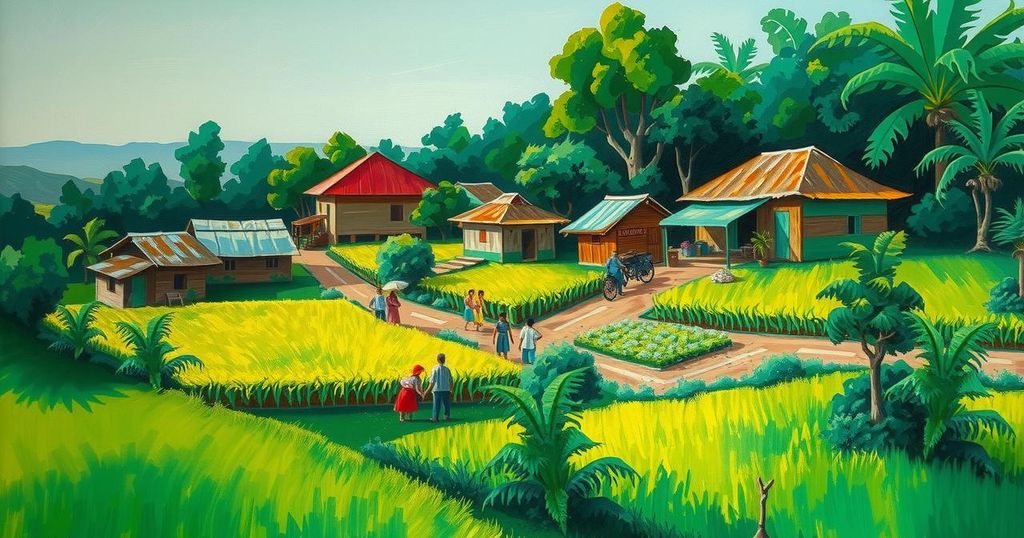Weather
World news
AFRICA, ANALANJIROFO, BEFANDRIANA AVARATRA, BETSIBOKA, BOENY, FORECAST, MADAGASCAR, MAMPIKONY, METEOROLOGY, NATIONAL METEOROLOGICAL SERVICE, NATIONAL OFFICE FOR RISK AND DISASTER MANAGEMENT, NATIONAL RISK ATLAS, NATURAL DISASTERS, RAIN, TEMPERATURE, WEATHER
David O'Sullivan
0 Comments
Tropical Cyclone Dikeledi: Preparedness and Potential Impact in Madagascar
Tropical Cyclone Dikeledi is predicted to strike northern Madagascar on January 11, with heavy rainfall expected to affect around 45,000 people. Preparatory measures, including emergency stock mobilization and community awareness, are underway to address the cyclone’s impact. The cyclone’s projected path may also reach Mozambique by January 12.
Tropical Cyclone Dikeledi is anticipated to strike the Vohémar and Antsiranana districts of northern Madagascar on January 11, 2025. Heavy rains have already commenced in the region, with expectations of more rainfall between January 11 and 13. Initial projections from the National Risk Atlas and the National Office for Risk and Disaster Management (BNGRC) indicate that approximately 45,000 individuals are likely to be adversely affected. In response, humanitarian partners have fortified their preparedness measures by supplying emergency stocks and organizing additional assistance. Meanwhile, awareness campaigns have been initiated in neighboring Mozambique.
As of 10:00 a.m. local time on January 11, Dikeledi was positioned 152 kilometers east of Vohémar, boasting winds of 120 km/h and moving west-northwest at 21 km/h. The cyclone is predicted to cause substantial rainfall across northern Madagascar, with Antsiranana expected to receive up to 170 mm of rain, raising concerns about possible flooding and landslides. Comparatively, the rainfall expected from Dikeledi is significantly less than that of Tropical Cyclone Gamane, which caused severe disruption in the same area last April. The distribution of affected individuals across various regions includes: 2,673 in Analanjirofo, 2,265 in Betsiboka, and 16,623 in Sava, among others.
Warnings associated with the cyclone have resulted in a red alert in the Sava and Diana districts. Yellow alerts are in effect for Bealanana, Antsohihy, and Analalava districts, while several other areas have been placed on green alert. It is projected that Dikeledi may traverse into the Mozambican channel on January 12. The Southern African Development Community (SADC) anticipates hazardous weather conditions, including heavy rainfall, gusty winds, and rough seas.
Efforts to enhance emergency response are progressing, including disseminating early warning information to vulnerable communities. Emergency supplies, originally mobilized for Cyclone Chido in December 2024, have been distributed. Cash assistance is being provided to 9,000 households, while humanitarian partners are dispatching 350 tons of food by boat. The National Emergency Operations Coordination Center (CNCOU) has been activated alongside pre-deployed teams to facilitate local coordination and potential evacuation actions.
Educational protocols have been initiated, with emergency educational stocks available across several regions. Medical supply pre-positioning is underway, supported by health partners. Water, sanitation, and hygiene (WASH) supplies are also being distributed, although needs persist. Additionally, food security partners have initiated crop seed distribution in affected areas. However, access to northern regions remains problematic due to infrastructural damage sustained from previous cyclones.
Awareness campaigns have commenced in Mozambique, with authorities anticipating Dikeledi’s impact to reach the Mozambican channel by January 12, as reported by Meteo-France.
Tropical cyclones are frequent in Madagascar, particularly during the cyclone season, which typically spans from November to April. Historically, these cyclones can bring catastrophic impacts, including inundation, landslides, and severe infrastructure damage. The response mechanism involving this cyclone reflects a multi-faceted humanitarian approach, illustrating collaboration among government entities, NGOs, and international partners to mitigate risks and address community needs during such emergencies. The recent precedents of cyclones, especially Tropical Cyclone Gamane, underline the urgency in preparedness and active response to safeguard the populations in vulnerable regions.
In summary, Tropical Cyclone Dikeledi poses a significant threat to northern Madagascar, with preparations underway to address the expected challenges. An estimated 45,000 individuals may face adverse outcomes due to the cyclone, prompting extensive emergency response measures. Continuous monitoring and the mobilization of resources are crucial in mitigating the impact of this storm and safeguarding affected populations. The collaboration between humanitarian partners and local authorities serves as a vital component in navigating the imminent crisis, reflecting a robust response to natural disasters.
Original Source: reliefweb.int




Post Comment